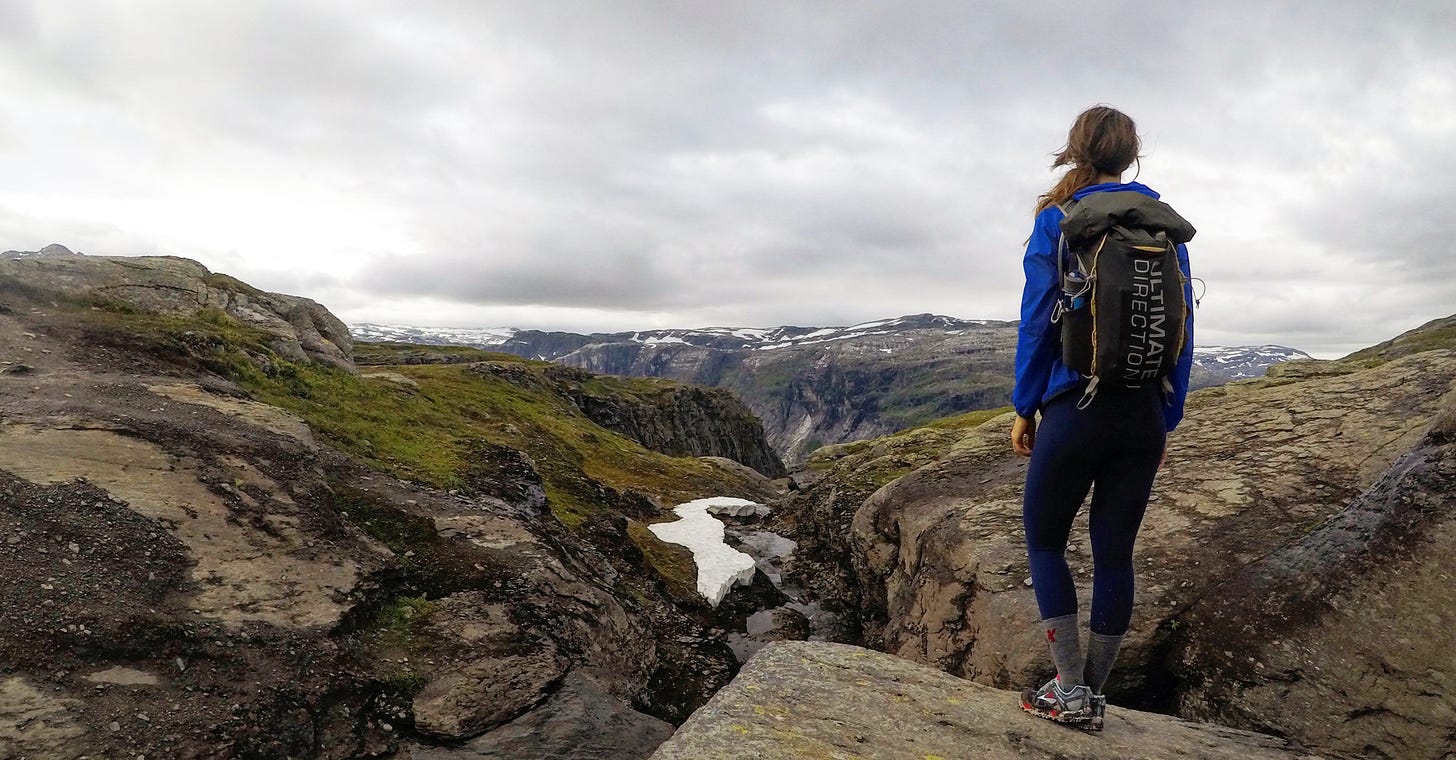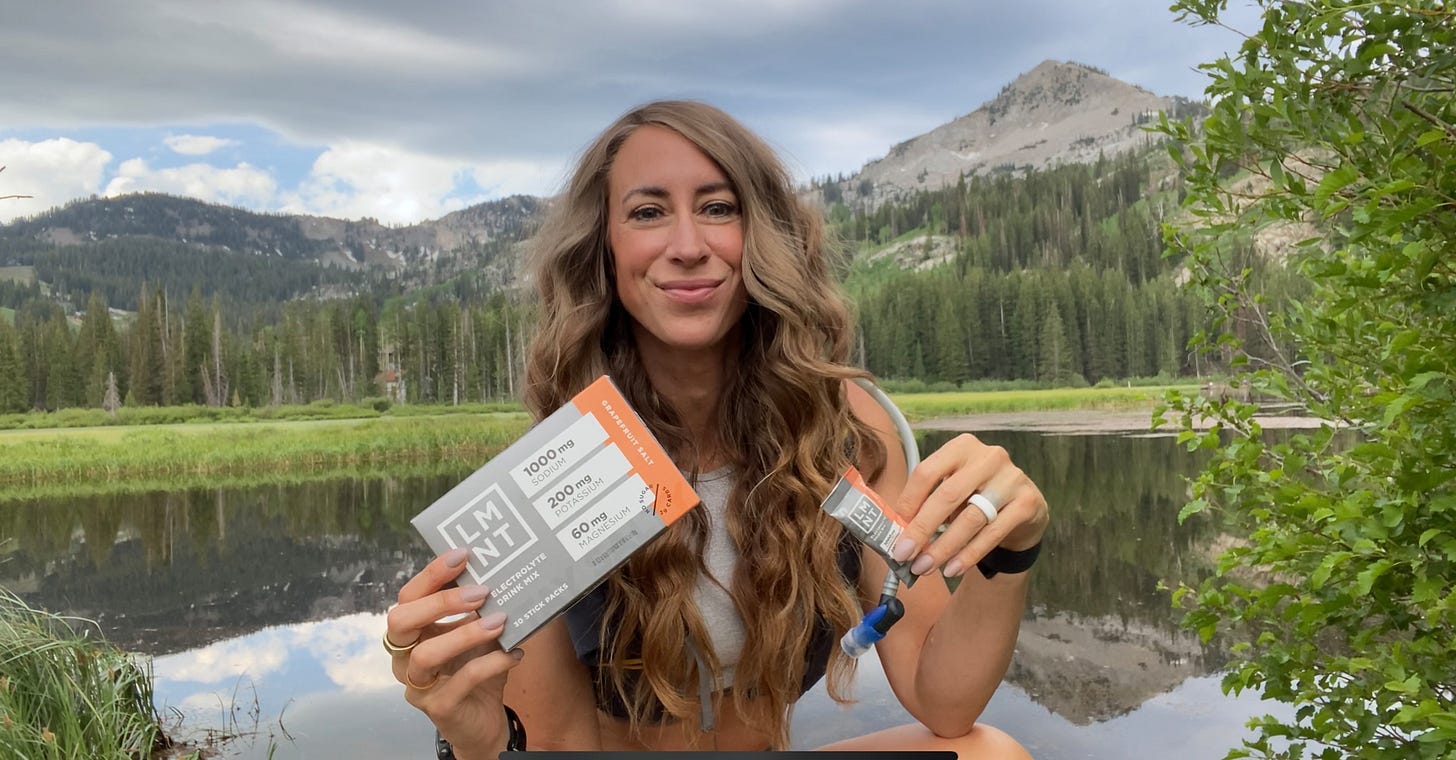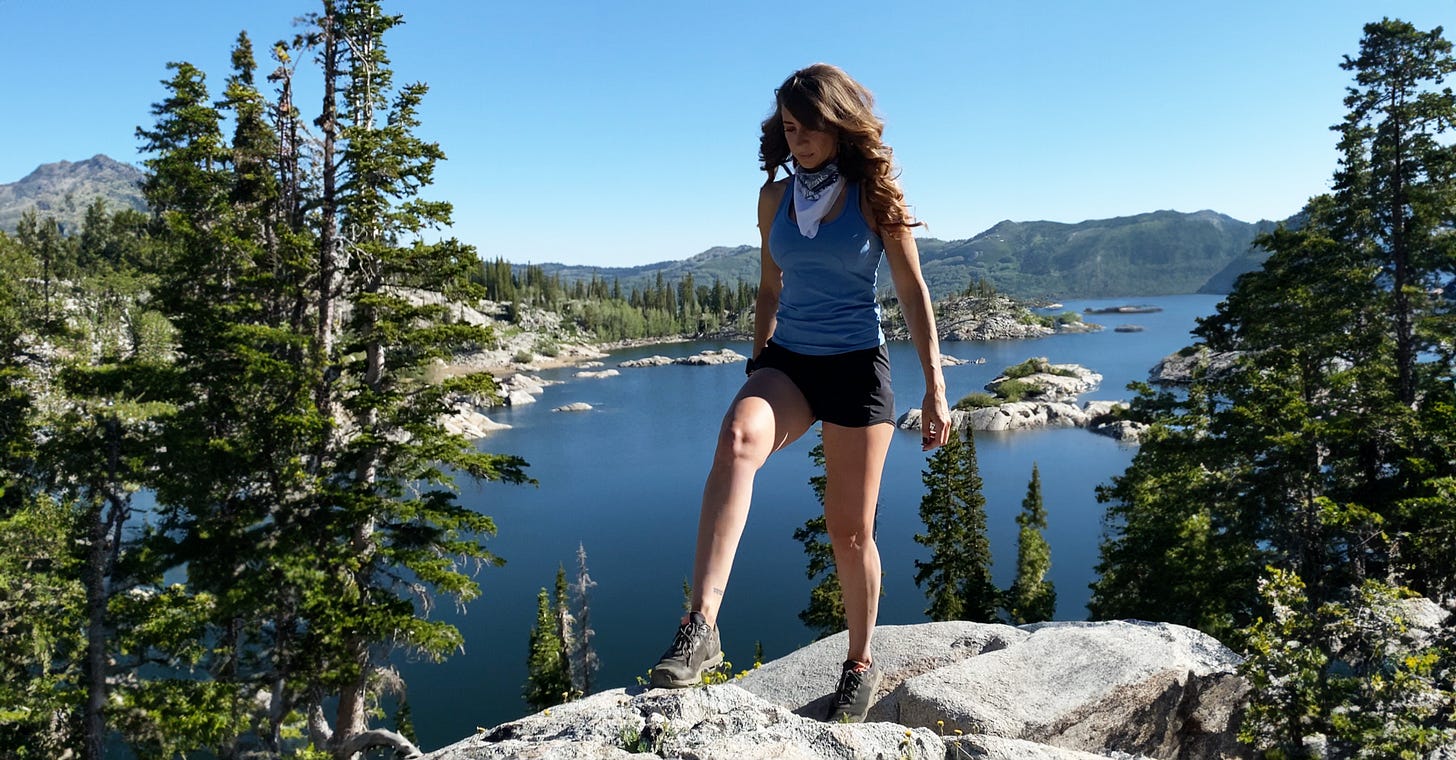XOMU: What's in my hiking pack
The essentials, nice-to-haves, snacks, and safety items in my day hike backpack
Are you ready for more of my summer hiking guides? Today, I’m sharing what’s in my pack every time I head out on the trail, keeping safety, comfort, and “leave no trace” in mind.
Day hike foundations
Day pack
I’ve used the same brand of day pack for 5+ years—the Ultimate Direction Fastpack ($150—on sale now for $100). (That’s the women’s version, designed for narrower frames. The all-gender is here ($150).) For day hikes in summer, 15L-20L is plenty big. It holds my base layer, rain jacket, snacks, water, a book, tripod, and even a small towel for swimming. If you have a family and are packing gear for more than one, consider sizing up to their 30L fastpack ($180). All of their bags have multiple pockets on the front straps for easy access to your phone, sunglasses, pepper spray, and snacks. They don’t have a waist belt, however, so if you’re really loading them up, they may not be as comfortable.
For shorter hikes or trail runs, I use the Ultimate Direction Adventure Vest ($180—on sale now for $100). It holds a 2L water reservoir, features the same convenient front pockets, and still has room for layers and snacks, but it’s got a lighter and tighter fit. This is what my 10-year-old wears when he hikes! It’s less cumbersome than a pack but lets him carry his own water, and fits him quite well. (The women’s/narrower version is here ($100).)
Water
Invest in a reservoir (sometimes called a “water bladder”) so you aren’t stopping every five minutes to take your pack off and fumble with a bottle. These 2L or 3L reservoirs go in a little pouch in your pack with a tube that goes straight to your mouth. I’ve been using this Hydrapack Shape Shift 3L reservoir ($35) that turns inside-out to clean—no more mucky, moldy corners where you can’t quite reach your sponge. Too much water is always better than not enough, and the UD Fastpacks above will hold that much.
I also add a Life Straw ($16) for longer hikes. They're small, light, and let you suck the most disgusting water out of a puddle or lake without fear. They're a hiking/backpacking must-have, but take the time before you hit the trail to learn how to use one. (They only work once they're "primed" with water. Practice at home.)
Energy
LMNT electrolytes
LMNT electrolytes are perhaps the most valuable item in my pack, besides water. It's always a good idea to replenish electrolytes, especially in summer. I throw two sticks of LMNT in my 3L water reservoir before I hit the trail for long hikes (one stick in 2L of water for shorter hikes). I also leave an extra packet of LMNT with 2L of fresh, cold water in my car, in case I use all my water on the trail and have a long drive home. Dehydration can happen fast on the trail, even if everything goes right. Sipping on electrolytes throughout my hike is a delicious way to make sure I stay energized, focused, and leg-cramp-free.
Get a free LMNT Sampler 8-pack with any purchase, plus free shipping!
Snacks
First, pack some protein in an easily digestible form. For me, that’s meat sticks, jerky, or Kreatures of Habit high-protein oatmeal made into overnight oats. Protein helps prevent muscle breakdown on the trail, and keeps fatigue at bay.
Next, pack some carbs in whatever form works best for your body. I tolerate carbs incredibly well, and self-experiments have proven I function better on hikes with more carbs, not less. I rely heavily on ProBar energy gummies on the way up the trail. They’re just sugar, perfect for steep/long climbs or longer hikes. Be careful, as some flavors contain caffeine! (It will say “yerba mate caffeine” on the stripe on the front of the package.) I also lean on dried mango—I like the Whole Foods 365 brand. This has so many carbs per serving, which is perfect for big activities.
I often pack cold Serenity Kids veggie pouches too—Roots are my favorite, but this only has 10g of carbs. (I eat them more because cold veggie mash on a trail tastes delightful.) I also stock up on RXBARS variety pack, Bobo’s oatmeal bars, or Lemon Larabars. You can also pack granola, which is easy to snack on. I like Purely Elizabeth, but you can buy grain-free if you don’t want oats. I rarely pack fresh fruit because it tends to get bruised or squished, but you could.
Finally, don’t forget healthy fats for both the calories and the energy. Try coconut chips, nuts and seeds (any will do, but I love Karma Nuts), single-serve almond butter or peanut butter, or trail mix (this Monster brand is my favorite, but it’s WICKED energy-dense, so a little goes a long way).
Basic rule of thumb—feel free to bring any food that you know works in your system. Never eat anything new on the trail; always test it out at home first. And bring more than you think you need in case the hike runs long, it’s harder than expected, or you decide to chill at the lake for a while.
Save 20% on Kreatures of Habit high-protein oatmeal with the code MU20.
Comfort
Windbreaker and/or rain jacket
Based on weather, I always pack one or the other (or both). There can be a 20+ degree temperature difference from base to summit, and in certain areas (like Colorado), summer thunderstorms are a daily occurrence. Windbreakers can also protect you from the sun, wind, and bugs without overheating; they’re not water proof, but they pack down tiny, so just keep one in your bag. (I currently wear a Black Diamond, but I also have a few Cotopaxi Teca ($80)! They’re more affordable and work really well.)
Baseball hat
I always have a hat strapped to my pack. It’s helpful for sun, rain, and wind. Any hat will do, as long as it doesn’t make your head super sweaty. My absolute favorite hat came from a little shop in Jackson Hole.
Bug spray
You are always asking me what kind of bug spray I bring, assuming I use some natural, organic stuff. I do not. It doesn’t work. I keep a small bottle of Ben’s DEET 30% in my pack at all times. Mosquitos can pop up as the weather, terrain, and environment changes, and the difference between a pleasant hike and a miserable one is… DEET.
Kula cloth
My love for Kula Cloth ($23) runs deep. Kula is a technical pee cloth designed for people without penises. Instead of drip-drying, you wipe with their anti-microbial cloth, which absorbs the moisture and dries (clipped to the outside of your pack) super-fast. It’s a much more elegant way to pee on the trail than packing in your own TP, which you then have to pack out. Kula Cloths are also great for road trips, camping, and any other activity in which you might have to cop a squat.
T.P. and a Ziploc
That having been said, I always make sure I have a few tissues or squares of TP in case I have to blow my nose, get a nosebleed, or need to poop. (Rare, but it can happen.) Pack everything out—hence the Ziploc.
Camp towel
I bought a Nomadix mini-towel ($28) a few years ago, and it’s my most beloved comfort item. It gives me a comfy or dry space to sit, helps me dry off after a swim (or if I get sweaty), and cools off my hot leather seat when I get back to the car. It takes up so little space but it’s so functional.
Safety
Bandana
Bandanas are super versatile. They function as a hair tie or headband, sun protection, bug protection, or in a pinch, to help set an injury or stop bleeding. Tie one to the outside of your pack and leave it there. (Here you WANT 100% cotton, as that’ll absorb sweat or blood best.)
Headlamp
I keep a headlamp ($15+) in my pack at all times. I’ve never had the kind of emergency that necessitates one, but if you get lost, decide to stay late, or something goes wrong, you’ll be glad you have it. It’s tiny, light, and no trouble to keep in your pack. Ideally, it features multiple brightness levels and pivots to different angles.
Multi-tool
I don’t always take this with me, but on long hikes, it’s small and easy to toss in. It’s helpful for gear repair, first aid, and opening a tenacious Chomps wrapper. You can get a cheap one, but my dad likes Leatherman ($100+), and this one has a fire-starter and emergency whistle built right in.
Matches or lighter
This is something my Army Ranger friend scolded me for not having on a hike we did together many years ago. God forbid you get lost or injured and have to spend the night on the mountain; having a way to make fire can save your butt.
Pepper spray
If you’re nervous about the two-legged animals found on the trail, keep a bottle of Sabre pepper spray ($10) in a handy spot (or carry it in your hand). Make sure you know how to use it, okay? I’ve never had to pull it out, but I’m glad I have it.
Personal alarm
Another safety option is a personal alarm. I have a Birdie ($30), and that sh*t is LOUD. You can clip it to the outside of your pack and pull it to draw attention or scare someone off.
Garmin InReach (optional)
This is a helpful tool for staying safe on the trail, although it’s an investment. I rarely have cell phone signal when I hike (whether in Utah or other states), and the InReach Mini ($385) is a 2-way satellite communicator that lets you send two-way messages, share your location, and call for help.
Seasonally at altitude, spikes
I know it seems bananas to bring microspikes ($75) on the trail in June, but if you’re heading up to 9-10K feet, snow can stick around until June or July! (There are still some summits here that aren’t quite passable yet.) It depends on the trail and how much snowfall we’ve had in winter, but I’ve seen folks risk a nasty fall because they weren’t prepared to encounter deep slush on a steep face.
Also recommended
Hiking experts will round out these safety items (known as the “ten essentials”) with a first aid kit, a lightweight space blanket, and back-up sunscreen in case you need to apply more on the trail. You also might want to consider trekking poles for longer trails, rocky or steep terrain, or water hikes. (I like the ones that fold down for easy storage.)
Here’s the thing—some people feel more prepared with ALL the gear, while I tend to pack lighter on familiar local trails that I know are popular. What we’re NOT gonna do is shame anyone for using poles (or spikes, or carrying 3L of water) on any trail, ever. Use this article as a guide to find the gear that works best for your hikes, budget, and level of comfort, and get out there!
XO, MU
Additional resources:
Summer hiking clothes for 2023 (article)
Guide to summer hiking with special guest Kristen Bor (podcast)
Guide to hiking in Jackson, WY and Grand Teton National Park for 2023 (article)
Going to church: Why I call the mountains “church” (podcast)








Ok, so I might be *slightly* biased 😂😂 but I feel pretty honored to see Kula Cloth on your list ❤️ AND I have to thank you for introducing me to the LMNT electrolytes. I’ve been drinking them for years now and the mint chocolate is my ‘go to’ hot drink for backpacking trips.
Such great recommendations!!! Thank you!!